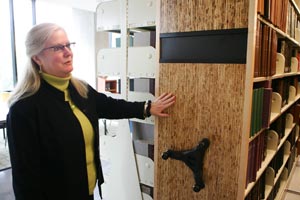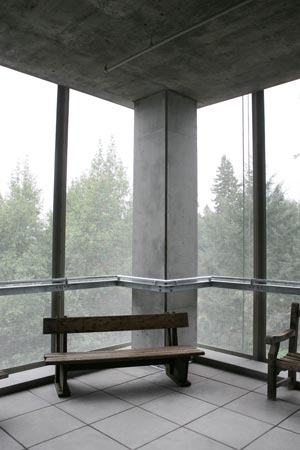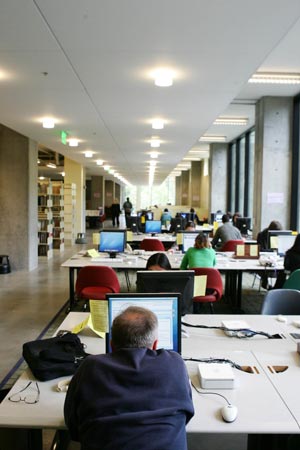How do you maneuver an 800-pound shelving unit around a sharp corner, down a narrow corridor, and through a small doorway? You don't.
Just ask Virginia Steel. Over spring break, the University Librarian oversaw the move of materials from the original McHenry Library into the library's recently opened new addition.
The transfer, which was performed by a company in Chicago that specializes in library moves, was in preparation for the renovation and seismic retrofit of the old building. That will take 18-24 months, during which time the original library will be closed.
"It was not a spring 'break,'" said Steel, wearily, though with an excited smile. Despite a huge number of materials and some unwieldy items, the move to the addition went remarkably smoothly, she said, while walking through the modern, concrete-and-glass structure on a recent weekday afternoon. An overcast sky sent white light filtering in through enormous, floor-to-ceiling windows, and a swath of mist-enshrouded redwood trees seemed to envelope the building. Students and others quietly studied or sat at computers.
"It looks like a modern library," said Steel, who looked the part of a modern librarian in a lime-green turtleneck and matching earrings. "Our old library felt more closed in and not as inviting, I think."
But, she added, feedback on the addition has been both positive and negative, with some patrons saying it's too industrial for their taste.
The overall cost of the project is $99 million, with the state providing $86 million, according to Steel. Roughly 40 percent of the cost of the renovation phase is for seismic and life-safety improvements in the old building.
Spring forward
The moving company brought 35 employees and hired about 25 students to perform the transfer of 700,000 volumes, 11,000 videotapes, 5,000 DVDs, 16,000 CDs, 1,100 laser discs, and 71 microforms cabinets.
The movers did get that 800-pound compact shelving unit, which houses CDs and DVDs, into the new space. But they had to use a different entryway with its door removed from the hinges.
Oversized materials in Special Collections also proved awkward to move, said Steel. The photographs, maps, art prints and the like had to be individually walked around the outside of the building with several movers carrying each of the 65 enormous, flat drawers they're stored in.
Though some finishing touches are still in progress, the library is now open, and access to the new addition is available through a temporary entrance on the southwest side of the addition (the Performing Arts side).
The expansion of the library has been a dozen years in the planning. When it's complete, it will create "a contemporary, 21st century library where we'll have the kinds of spaces students expect and need," said Steel. "We want to make this more of a destination spot, both for students and for faculty."
But before it can do all that, the library has to squeeze into the new, approximately 81,600 square feet of space in the addition, since the existing, 114,000-square-foot library, built 42 years ago, will be gutted down to its exterior walls, said Steel.
Library staff downsized the collections in the years before the move, put some items in storage, and sent materials and staff temporarily to the Science & Engineering Library so that everything could fit in the addition while the original McHenry Library is renovated.
To help conserve space, half of the shelving in the addition is on tracks. The shelves, called compact shelving, can therefore sit right up against each other. Using a hand crank, library patrons can roll a shelf unit to one side to create a temporary aisle space.
Library of today
The end panels of the shelving, as well as other elements in the library, are made of kirei--a "green" building material that consists of compressed sugar cane or sorghum.
Standing near the library's 1960s-era furniture--new furnishings will be purchased later, but for now chairs and tables are, well, retro-chic--Steel gestures to the terraced lawn between the addition and the original library.
The lawn has wireless connectivity, and its curved terrace walls have electrical outlets, so people can plug in and enjoy the sunshine.
When finished, the library will offer features including:
- An electronic research center with 60 stations to access library resources.
- A visual resource center, providing access to electronic graphic files and image banks, 35 mm slides, and historic collections in various photographic formats.
- An instructional design center to help faculty make innovative use of technology in instruction and research.
- A "cyber study" room and café--an Internet café providing social gathering space and online access.
- Distance-learning facilities, providing support for students and faculty at remote locations, such as Silicon Valley.
- A film and music center, providing access to a wide range of nonprint media, including video and audio recordings, CD-ROMs, and DVDs.
- Expanded, up-to-date facilities for Special Collections.
- Wireless networking throughout the building.
- Additional electronic workstations and a number of group study rooms to foster collaborative learning.
The old building, when renovated, will include Special Collections, circulation and reference, library administration, processing, and faculty offices.
The addition will include the media center, visual resources, and some general collections.
For the latest news about the McHenry project, visit the McHenry Library Addition and Renovation Project page.
Steel invites faculty to write with suggestions and ideas for making the library more appealing to them.
Contact the author at gwenm@ucsc.edu.






